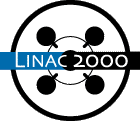
F.-J. DECKER, S. DEBARGER, R.H. IVERSON, P. RAIMONDI (SLAC)
These days the linac at the Stanford Linear Accelerator Center (SLAC) is mainly an injector for the PEP-II rings. But besides the electrons and positrons for PEP-II, it provides a 30 GeV electron or positron beam to the end of the linac into the FFTB (Final Focus Test Beam) area or creates a test beam for the A-Line. In the FFTB tunnel there are two plasma experiments installed, which have demonstrate plasma focussing and plasma acceleration up to 0.5 GeV/m. The acceleration goes linear with the current and is inversely proportional to the square of the bunch length. Therefore we are pushing the bunch length to shorter and shorter values adjusting the R_56 in the RTL (Ring-To-Linac) compression section and pre-compressing the bunches in the damping ring. The non-linearity of the RF and the higher order dispersion are becoming more important for bigger compression factors. Then the high-charge, short bunches will create strong longitudinal wakefields in the linac. They create a double-horned energy profile and have different beam dynamics than a long bunch in the linac. Measurements of the beam properties, like stability, distributions, tails, and backgrounds are discussed in this paper.
*Work supported by Department of Energy contract DE-AC03-76SF00515.
Comments or Questions to
linac2000@slac.stanford.edu